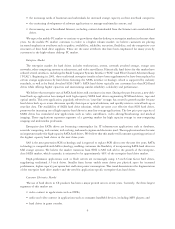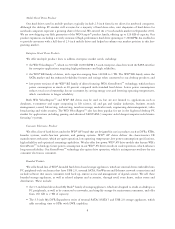Western Digital 2008 Annual Report Download - page 15
Download and view the complete annual report
Please find page 15 of the 2008 Western Digital annual report below. You can navigate through the pages in the report by either clicking on the pages listed below, or by using the keyword search tool below to find specific information within the annual report.• the 2.5-inch hard drive-based My Passport»Portable series of USB 2.0 and FireWire storage devices, which,
weighing less than one-half of a pound, offer from 120 GB to 320 GB of portable storage capacity; and
• 3.5-inch and 2.5-inch internal hard drives packaged with PC installation kits under the WD brand for retail store
sales.
Research and Development
We devote substantial resources to development of new products and improvement of existing products. We focus
our engineering efforts on coordinating our product design and manufacturing processes to bring our products to market
in a cost-effective and timely manner. Research and development expenses totaled $464 million (excluding $49 million
of in-process research and development acquired in the acquisition of Komag), $306 million and $297 million in 2008,
2007 and 2006, respectively.
For an additional discussion of risks related to our development of new products, see Item 1A of this Annual Report
on Form 10-K.
Technology and Product Development
Hard drives record, store and retrieve digital data. Performance attributes of hard drives, such as their ability to access
and transmit data and storage capacity, are currently better than removable or floppy disks, optical hard drives and tapes, and
they are more cost effective than semiconductor technology. The primary measures of hard drive performance include:
• “Acoustics” — which is the sound power emitted during hard drive operation, commonly expressed in decibels,
and perceived loudness due to sound pressure, commonly expressed in sones.
• “Data transfer rate” — which is the sustained rate of data transfer to and from the disk, commonly expressed in
megabits per second. One megabit equals one million bits.
• “Seek time” — which is the time needed to position the heads over a selected track on the disk surface, commonly
expressed in milliseconds.
• “Spindle rotation speed” — which is the nominal rotation speed of the disks inside the hard drive, commonly
expressed in RPM or latency. Spindle rotation speeds commonly stated as 5,400, 7,200 and 10,000 RPM are
sometimes approximations.
• “Storage capacity” — which is the amount of data that can be stored on the hard drive, commonly expressed in
GB or TB. As defined in the hard drive industry, one GB equals one billion bytes and one TB equals one trillion
bytes. A byte is a digital character, typically comprised of eight bits. A bit is a binary digit, the smallest unit of
information in a digital system.
• “Power Consumption” — which is the amount of electricity required to operate the drive, measured in watts.
All of our hard drive products employ similar technology. The main components of the hard drive are a Head-Disk-
Assembly (“HDA”) and a Printed Circuit Board Assembly (“PCBA”). The HDA includes heads, media (“disks”), head
positioning mechanism (“actuator”) and spindle motor. A rigid base and top cover contain these components in a
contamination-controlled environment. The PCBA includes both standard and custom integrated circuits, an interface
connector to the host computer and a power connector.
HDA: One or more disks positioned around a motor-driven spindle hub that rotates the disks comprise the disk-
pack assembly. The disk is made up of a smooth substrate on which thin layers of magnetic materials are deposited. The
HSA is comprised of a magnetic positioner, a pivot-arm module, on which the individual heads are mounted. Each disk
has a head suspended directly above it, which can read data from or write data to the spinning disk.
PCBA: The integrated circuits on the printed circuit board typically include a drive interface and a controller. The
drive interface receives instructions from the host computer, while the controller directs the flow of data to or from the
disks and controls the heads. The location of data on each disk is logically maintained in concentric tracks divided into
sectors. The host computer sends instructions to the controller to read data from or write data to the disks, based on
9
























